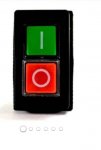Ok
i have a car charger in a commercial setting
basically....if I lose power and my generator comes on...I Do Not want the charger running off my generator
I’m happy to manually reset the breaker feeding the charger once power is restored...what can I add to simply open the breaker upon power loss.
maybe something like a ‘holding contact’ works in a starter
i have a car charger in a commercial setting
basically....if I lose power and my generator comes on...I Do Not want the charger running off my generator
I’m happy to manually reset the breaker feeding the charger once power is restored...what can I add to simply open the breaker upon power loss.
maybe something like a ‘holding contact’ works in a starter



